AMD Ryzen Threadripper 7980X & 7970X Review: Revived HEDT Brings More Cores of Zen 4
by Gavin Bonshor on November 20, 2023 9:00 AM EST- Posted in
- CPUs
- AMD
- HEDT
- ThreadRipper
- Zen 4
- Threadripper 7000
- TRX50
TR 7000 vs. Intel: Encoding
One of the interesting elements of modern processors is encoding performance. This covers two main areas: encryption/decryption for secure data transfer and video transcoding from one video format to another.
In the encrypt/decrypt scenario, how data is transferred and by what mechanism is pertinent to on-the-fly encryption of sensitive data - a process by which more modern devices are leaning towards for improving software security.
We've updated our list of encoding benchmarks for our 2024 CPU suite to include some of the most relevant and recent codecs, such as AV1, HEVC, and VP9. Not only this, but we have also included FLAC audio encoding as well as WebP2 image encoding into the mix to show not only how the latest processors perform with these codecs but also to show discrepancies in performance throughout the different segments.
We are using DDR5-5200 RDIMM memory on the Ryzen Threadripper 7980X and 7970X as per JEDEC specifications. For Intel's Xeon W9-3495X, we are using DDR5-4800 RDIMM memory as per Intel's JEDEC specifications. It should be noted that both platforms are run with their full allocation of memory channels, eg, TR7000 in 4-channel and Sapphire Rapids in 8-channel.
Below are the settings we have used for each platform:
- DDR5-5200 RDIMM - AMD Threadripper 7000
- DDR5-4800 RDIMM - Intel Xeon Sapphire Rapids WS
- DDR5-5600B CL46 - Intel 14th Gen
- DDR5-5200 CL44 - Ryzen 7000
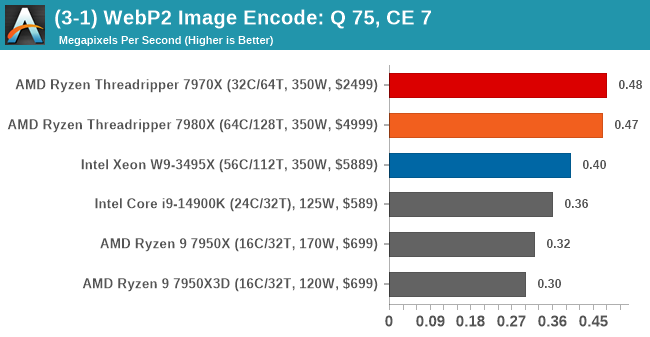
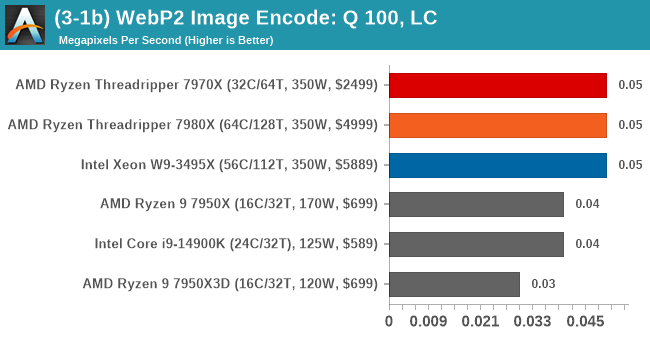
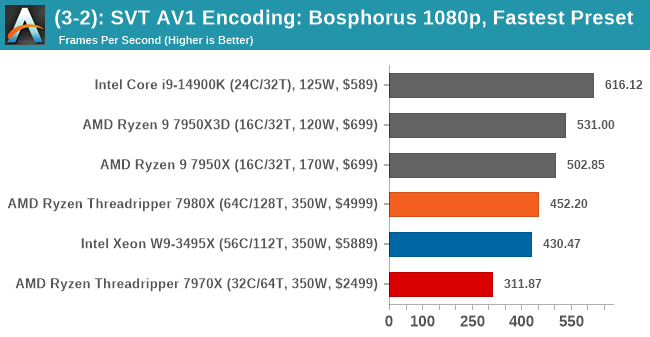

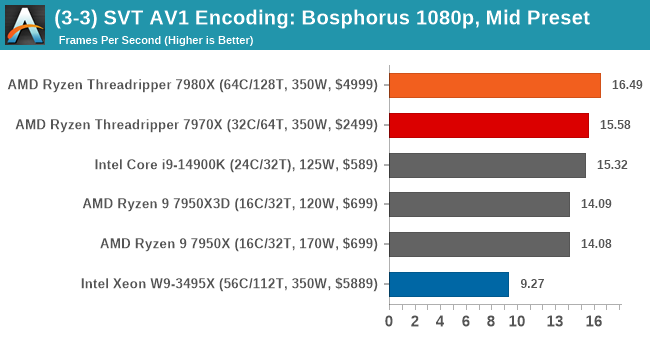
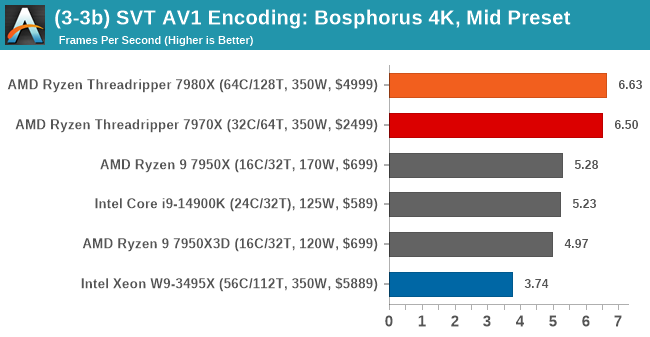
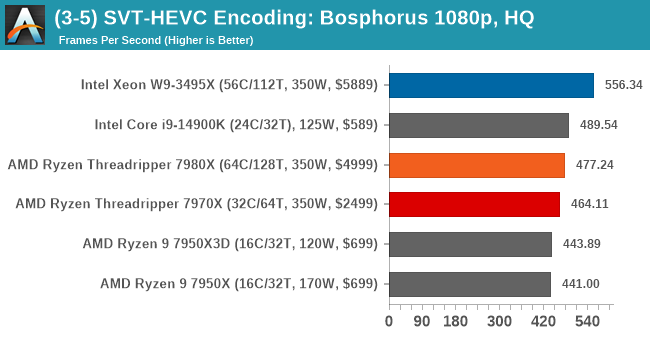

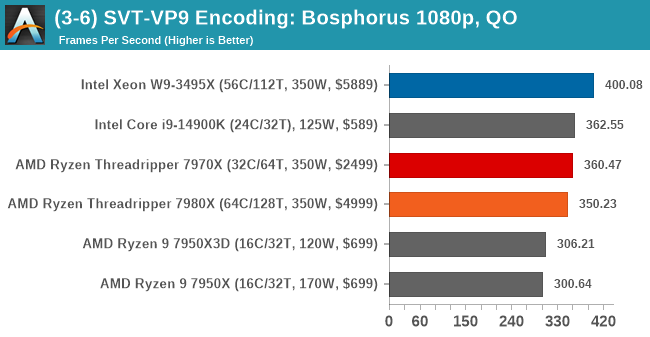
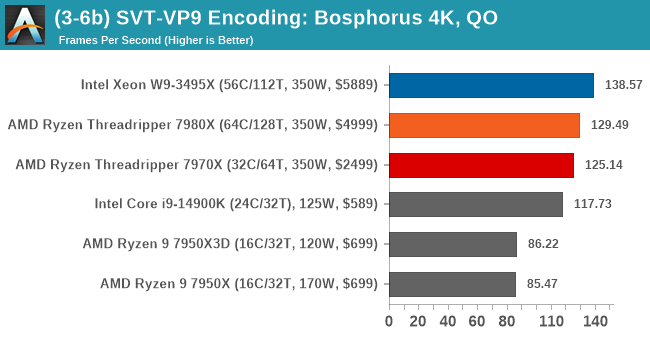
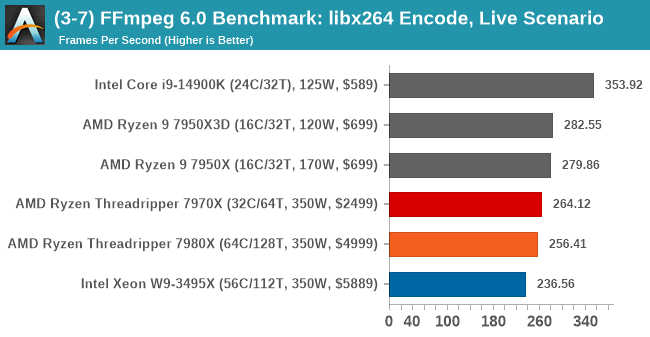
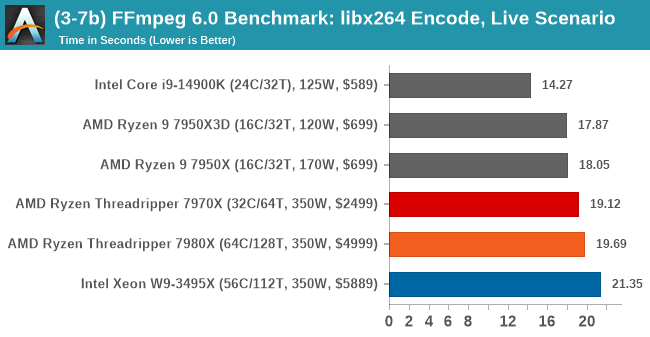
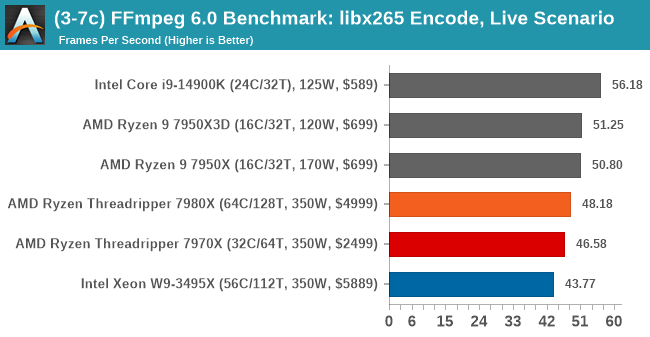
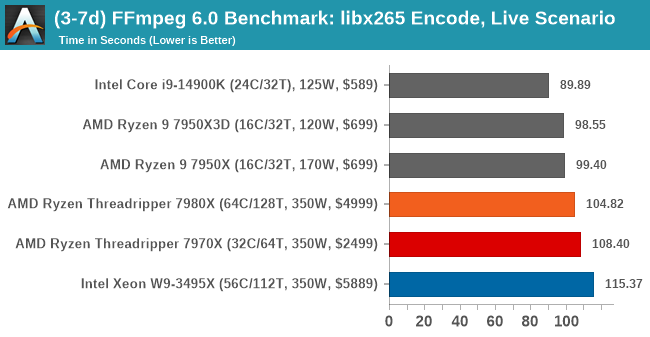

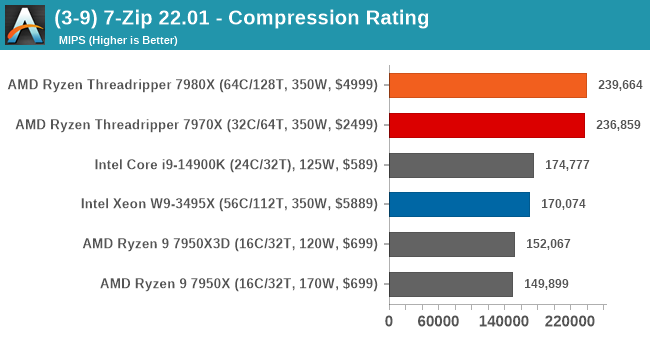
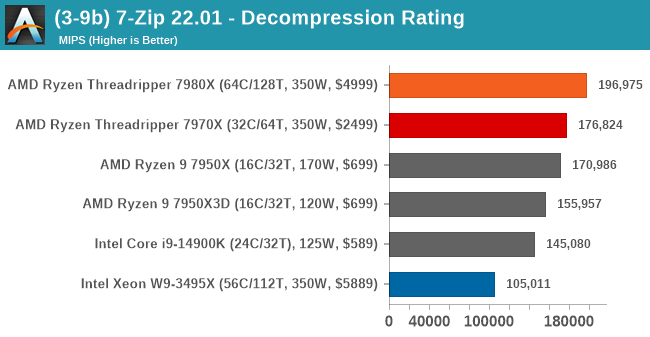
Starting with the WebP2 Image encoding tests, the Ryzen Threadripper 7980X and 7970X perform well compared to the other chips we've tested. Interestingly, in the SVT AV1 encoding using the fastest preset, the desktop chips with the faster core frequencies win. The tables turn using the mid preset, with both Threadripper 7000 chips sitting on top of the charts.
In the SVT-HEVC benchmark, the Intel Xeon W9-3495X sits at the top of the list, and the same is prevalent in the VP9 encoding benchmark. In the FFmpeg 6.0 benchmark with x264 and x265, the desktop processors with the faster cores win in this situation, with the Core i9-14900K and the 6.0 GHz boost core frequencies playing a bigger hand than simply having more cores.
Looking at 7-Zip performance, both the Threadripper 7980X and 7970X are vastly superior to the Intel Xeon W9-3475X and the flagship desktop chips, including the Core i9-14900K, Ryzen 9 7950X, and Ryzen 9 7950X3D.










66 Comments
View All Comments
Threska - Wednesday, November 22, 2023 - link
Sounds like the complaint of a cheap person that doesn't want to spend their money on anything. Starts with a fruit-vegetable comparison and ends with an absurdly low-balled figure.SanX - Thursday, November 23, 2023 - link
It is better to be cheap than dumb. I wrote TR is 2x faster than consumer 7950X? Let's take this more precisely from "Science and Simulation" for example as scientists should do. Out of its 13 tests the TR 7980x won only 5. Even more, taking the mean square root of test ratios we can get that TR actually only 33% faster than 7950X3D. Couple tests look like a single core taking them out changes this outcome just 5%. What a misery, it is actually a TOTAL DEBACLE! Buy the way, just in case.tell your relatives to take the credit card from youBushLin - Thursday, November 23, 2023 - link
Tonight's Headlines:Guy on the internet with a narrow use case decrees AMD's entire HEDT lineup BS. His application runs just as well on a consumer platform so no one else could possibility find value...
SanX - Sunday, November 26, 2023 - link
YMMVSanX - Thursday, November 23, 2023 - link
"You know how much it costs to develop these chips? AN insane amount of money."OK, tell us how much exactly.
AMD first introduced chiplets in 2015. The cost of that development returned many times since. As to the cost of chiplets themselves, Zen4 chiplets have around 6B transistors. Apple Bionic A14 chip has twice of that and costs $17. Do the math
Shmee - Wednesday, November 22, 2023 - link
I wonder why there is no 16 core option. It would be nice to have a less expensive HEDT CPU for gaming, with higher clocks. Also, why no gaming benchmarks?Oxford Guy - Wednesday, November 22, 2023 - link
Games aren't designed to leverage these chips (too many cores, not enough clock, no 3D cache, too much inter-module latency).Games are designed for low-end CPUs, comparatively.
As for a 16-core version, it wouldn't be enough cores to justify the cost of the motherboard unless AMD were targeting extreme clocks, which the company isn't.
mvkorpel - Thursday, November 23, 2023 - link
The 7970X actually has a max boost clock of 5.3 GHz, according to AMD. It is reported as 5.1 GHz in the article.PeachNCream - Sunday, November 26, 2023 - link
HEDT is a terribly scammy space for CPUs. The markup for overall compute power is high, the maximum CPU clocks are low, power consumption and cooling is crazy, and then there is the biggest issue - per CPU memory bandwidth to RAM. Modern 4-8 core laptop CPUs get two memory channels. This chip gives you a measly 4 channels far more processor cores to squabble over. That's woefully inefficient scaling to say the least and I'm sure someone will start crying about wiring complexity in a world where we have 172-layer stacked NAND and hundreds of CPU cores on a single chip package while ignoring that wiring for 8 memory channels would be trivial with a little bit of effort and thought put into it.TomWomack - Monday, November 27, 2023 - link
Usually secondhand last-generation servers are a better source of pure computrons than HEDT; on the other hand third-generation Xeon Scalable with eight channels per processor hasn't made it to the second-hand market yet, and whilst the less-popular many-core Skylake CPUs are under £100 the base systems are still quite expensive and the stock levels aren't great.